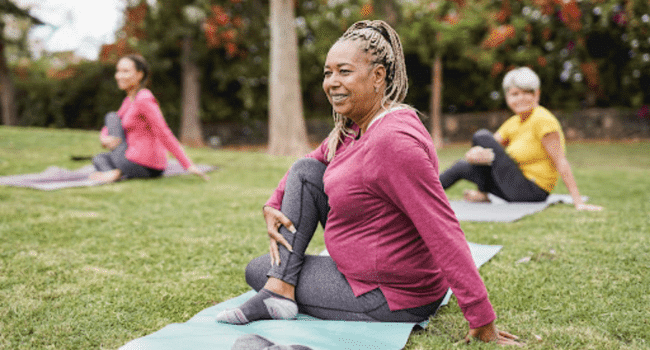Table of Contents
In case you like the idea of meditating but sitting still for an extended period doesn’t do it for you, movement meditation may be for you. Combining movement and mindfulness is a popular way to practice cultivating a sense of calm in your everyday life, and it may be more accessible to some people. In this article, we explore mindful movement and how to use it to develop a similar sense of calm that one would achieve during meditation.
What Are the Benefits of Meditation and Mindful Movement?
Meditation is a fundamental part of mindfulness practices, encouraging you to focus on the present moment and slowing your mind. Over the years, more researchers have published their findings, discovering that the possible benefits of meditation are vast. Some of these studies indicate that meditation and mindfulness have the following benefits:
- Contributes to healthy aging;
- May reduce symptoms of anxiety and other mood disorders;
- Lowers blood pressure;
- Improve mental clarity;
- Ease stress symptoms by reducing cortisol (the stress hormone);
- Promotes creativity;
- May aid symptoms of ADHD;
- May ease symptoms of insomnia.
If you’re reconsidering and want to try meditation again, why not start with mindful movement? Movement meditation is the idea of entering a meditative state while doing simple activities or movements. Rather than sitting in the same position with your eyes closed for a long time, inviting in movement welcomes curiosity into your practice. It allows you to develop a mindfulness habit in multiple areas of your life.
5 Mindful Movement Meditation Ideas
There are many ways to weave mindfulness into your life; here are a few ideas if you’re keen to try movement meditation.
Yoga
Slow stretching and yoga flows are great ways to experiment with mindful movement meditations. Slow down your usual practice and hold each pose for a few seconds longer. Begin to sync your movements with your breath as you inhale and exhale. As you focus on syncing your breath with your body, you can tune into the physical sensations you’re experiencing, do a body scan and check in with every part of yourself. This exercise allows you to be more in touch with your body and increase self-awareness.
For an extra dose of calm and comfort, some people like to pair their yoga or mindful movements with CBD cannabis dips. This natural and non-intoxicating compound has grown in popularity for its potential relief from pain, sleep issues, and anxiety symptoms.
Walking
Many people enjoy walking meditation as it often combines mindfulness and nature. Start focusing on your breath, the flow of air as it enters and leaves your body. Then turn your attention to your surroundings. You may work your way through your senses, looking around at what you can see and noticing what you can hear or smell. Walking meditations are an excellent way to cultivate more presence in your day, as it helps you notice your surroundings with more focus and ease. You may enjoy a guided audio meditation designed to calm you while walking.
Daily Tasks
A common mindfulness technique is introducing breathing exercises into your everyday tasks, creating small moments of meditation throughout your day, something that can be deeply enhanced during a stay at health retreats Australia. While it may seem mundane to some, it can be a powerful way to bring peace and add meaning to every day. Some examples of tasks you may introduce mindfulness:
- Cleaning your dishes;
- Brushing your teeth;
- Having a shower;
- Drinking water;
- Eating a meal;
- Putting on or taking off clothing.
Gardening
Gardening has long been known for its calming, nurturing properties. Many people enjoy bringing mindfulness to their gardening sessions as they focus their attention on giving energy and care to other living things. In the same way as meditation, you may concentrate on the feel and texture of the soil, the sounds, scents, or visual aspects that interest you. Mindful gardening has even inspired many more people to care for indoor houseplants, especially if they lack an outside space.

QI Gong
Qi Gong is an ancient Chinese healing practice that translates to “the master of one’s energy”. This form of mindful movement combines controlled breathing, meditation, and slow, gentle motion. Experts say that Qi Gong promotes good physical, mental and spiritual wellness. In Traditional Chinese Medicine, bad health results from an energy block that prevents energy from flowing through the twelve sections of the body. Qi Gong is a practice to help unblock the flow of energy and restore wellness. Despite its immense popularity, more research is needed to confirm the benefit of this practice. However, it does offer a calming, restorative way to practice movement meditation.
Final Thoughts
There are various ways to introduce mindfulness into your daily life; movement meditation is one such way. However, if meditation isn’t for you and you’re not keen on these activities in this article, why not try other self-compassion exercises, such as journaling, to release stress, regulate emotions, and lower anxiety symptoms? Journal prompts for self discovery can be particularly effective in uncovering deeper insights about yourself and your life’s direction. Alternatively, as we mentioned above, you may enjoy trying natural CBD products, such as a non-intoxicating cannabis dip, to aid physical and mental ease.
Read more on KulFiy
